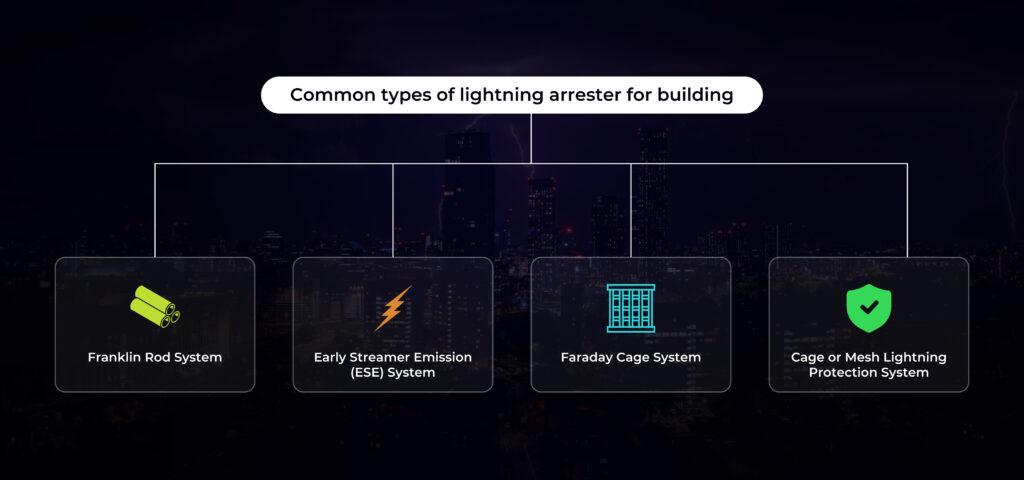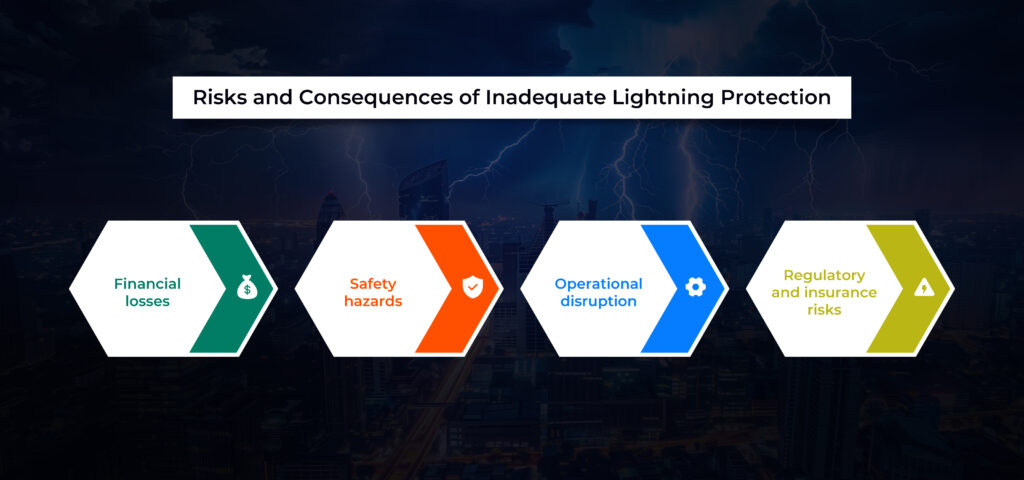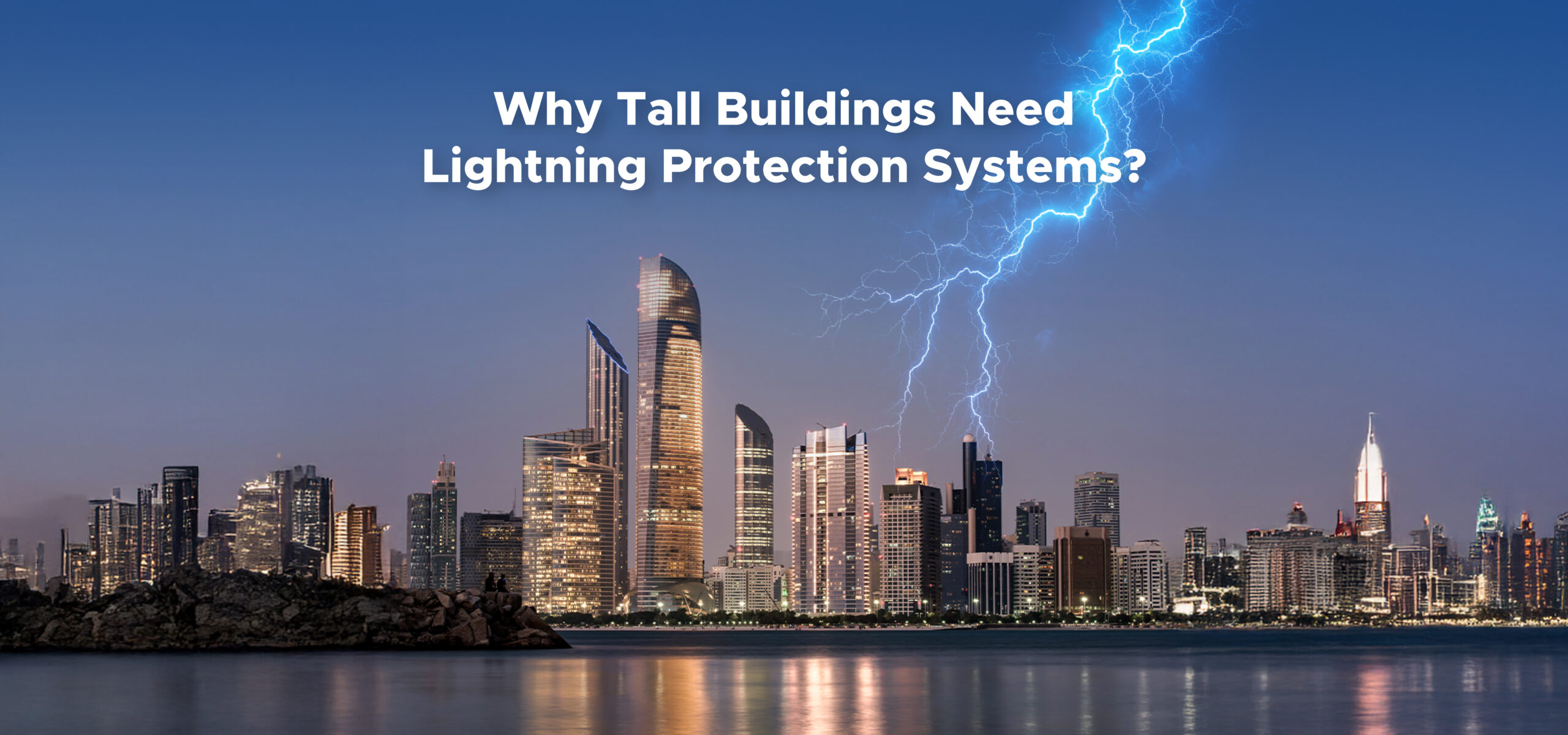In July 2025, a lightning strike hit One World Trade Center , lighting up the New York skyline and reminding us that even the tallest, most modern buildings are still at risk from nature’s power.
While the strike didn’t cause major damage, it highlighted a critical truth: without proper lightning protection and grounding systems, the results could be catastrophic. Such incidents, though infrequent, carry enormous risk, not only financially, but to life and infrastructure.
Lightning is nature’s high‑voltage discharge, capable of channelling hundreds of millions of volts in microseconds. For tall buildings, the threat is increased: their height, metallic framework, and conductive paths make them prime targets for lightning strikes on buildings. As urban skylines grow ever denser, the importance of lightning protection becomes non‑negotiable.
In this blog you will explore how lightning forms, why skyscrapers are especially vulnerable, the role of devices like lightning arresters, and the anatomy of a full Lightning Protection System (LPS) with knowing the emerging technologies shaping the future of protection and highlight how Manav’s LMAS (Lightning Management & Alert System) brings smart, proactive defense to tall buildings.
The Science of Lightning & Building Vulnerability
Lightning begins with charge separation in storm clouds: turbulence and collisions push negative charges downward and positive charges upward. A lightning protection system is essential in these environments to prevent operational and safety failures.
When the electric field between cloud and earth exceeds dielectric strength, a stepped leader descends, ionizing the air. When it approaches a grounded object, a return stroke surges upward, completing the discharge channel.
Tall buildings are especially vulnerable because they provide a shorter path to the ground. Their height and sharp features (edges, spires, metallic surfaces) concentrate electric fields, tempting downward leaders to connect. Conductive materials (steel rebar, metal cladding) act as preferred current paths if not properly grounded.
When lightning strikes on buildings, damage may occur in several forms:
- Structural damage: sudden expansion of heated materials, explosions of nonmetal parts, and cracking of concrete.
- Electrical damage & surges: massive transient currents induced in wiring, damaging transformers, panels, control systems, and electronics.
- Fire hazard: arcing or overheating in flammable materials or insulation.
- Secondary surges: even nearby strikes can induce overvoltage’s along cable runs or buried lines.
High-risk use cases include data center, hospitals, and communication towers, all of which demand continuous operation and are vulnerable to power disruptions or equipment failures due to lightning strikes on buildings. In such installations, a single direct strike or surge event can result in millions of dollars in damage, downtime, or loss of life safety systems.
Thus, understanding the physics and vulnerabilities is the first essential step before designing protection.
Understanding Lightning Arresters: The First Line of Defense for lightning Protection
A lightning arrester is a high-voltage protective device used to safeguard electrical systems from the damaging effects of direct lightning strikes on buildings. It is typically installed at key points in a power system, such as substations, transmission lines, buildings, and tall structures, to safely divert lightning energy to the ground, preventing insulation failure, equipment damage, or fire.
Key Function:
The primary function of a lightning arrester is to limit overvoltages caused by lightning by providing a low-resistance path to earth during high-voltage transients. Unlike surge arresters, which protect against internal switching surges or temporary overvoltages, lightning arresters are specifically designed to respond to extremely high-energy, short-duration transients caused by lightning strikes on buildings.
Common types of lightning arrester for building:

- Franklin Rod System: The classic lightning rod with a pointed metal rod that attracts lightning and safely channels it to the ground.
- Early Streamer Emission (ESE) System: An advanced rod that emits an early streamer to attract lightning sooner, offering a larger protection area for tall structures.
- Faraday Cage System: A network of interconnected conductors (like a metal mesh) around the building that protects by distributing lightning current safely around the structure.
- Cage or Mesh Lightning Protection System: A fine grid of conductors installed over the roof and walls to intercept lightning strikes and safely conduct the current to the ground; ideal for very tall or complex buildings.
5.Components and its Uses of a Lightning Protection System (LPS)
A complete LPS is designed to safely intercept a lightning strikes on buildings and guide its energy to earth without harming the structure or equipment. Its core components:
- Air terminals (rods or strike points) – Placed at the highest points or along roof ridges to attract the strike.
- Down conductors – Heavy conductors (copper or aluminum) that carry the current from air terminals down to earth.
- Grounding network – An array of buried conductors or mats that disperse current safely into the soil.
- Surge Protection Devices (SPDs) – Lightning arrester for building at electrical boards to block residual overvoltage’s.
- Equipotential bonding – Tying metallic elements (pipes, rebar, cable trays) into the system so no dangerous potential differences exist.
Risks and Consequences of Inadequate Lightning Protection

Failing to provide proper protection can have severe consequences:
- Financial losses include damaged equipment, structural rehabilitation, and lost revenue during downtime.
- Safety hazards: fires in wiring, explosions, injury or fatality among occupants.
- Operational disruption: Mission-critical systems, such as backup generators, medical devices, or server farms, may fail to function properly.
- Regulatory and insurance risks: Many jurisdictions require compliance with standards (such as IEC 62305 or NFPA 780). Non-compliance may void insurance coverage or result in legal liability.
In 2023–24, Uttar Pradesh (India) reported 174 deaths from lightning strikes in the state, prompting government directives to install lightning rods on tall buildings.
In another instance, a high-rise in Haryana underwent rigorous testing of its lightning arresters, where evaluated models exceeded industry standards in safely conducting simulated strikes to ground without causing damage to the building.
Ignoring protection is not just risky, it’s irresponsible when lightning strike on buildings and lives are at stake.
Emerging Trends in Lightning Protection Technology
Lightning protection is no longer just passive hardware; modern systems are becoming smart, integrated, and predictive.
- IoT & real-time monitoring: Sensors embedded in air terminals, down conductors, and grounding systems measure parameters such as resistance, surge events, partial discharge, and more in real-time. They send alerts when performance drifts or faults appear.
- Predictive analytics & AI: Using historical strike data, weather predictions, and site-specific models, systems are now forecasting lightning risk zones or imminent strike windows. For tall structures, “upward lightning” (initiated from towers) is a growing concern; recent research uses random forest machine learning on meteorological data for risk assessment.
- Advanced materials and design: Use of corrosion-resistant alloys, conductive composites, and optimized geometries reduce maintenance and improve durability. Hybrid systems combining traditional conductors with novel materials are emerging.
- Integration with Building Management Systems (BMS): Lightning protection is becoming part of the smart building ecosystem. Alerts, diagnostics, and preventive maintenance can relate to HVAC, security, and facility management dashboards.
- Assisted discharge and active systems: Experimental approaches (e.g. drone-based or early-streamer-emission techniques) aim to pre-emptively direct lightning before conventional leader’s form. These are still in pilot or research stages.
- Regulatory push & retrofit demand: As global standards like IEC 62305 gain traction, new buildings are increasingly required to have certified lightning protection. Retrofitting older high-rises is now a growing segment of the protection market. (24 Market Reports)
Together, these trends are shifting lightning protection from “install and forget” hardware to an intelligent, continuously managed system.
How Manav’s Lightning Management and Alert System (LMAS) Keeps Buildings Safe
Manav’s LMAS (Lightning Management & Alert System) bridges the gap between conventional protection hardware and digital intelligence. LMAS provides smarter lightning protection for buildings, minimizing damage, downtime, and risk. LMAS is an advanced solution designed for tall buildings and critical infrastructure. Here’s how it works:
Real-time lightning tracking: LMAS use three types of sensors to predict the likelihood of lightning:
- Electromagnetic Sensors
- Electrostatic Sensors
- Ambient Weather Sensors
These sensors work together to monitor atmospheric conditions and provide early warnings of potential lightning activity.
- Predictive alerting: When indicators cross thresholds (e.g. rising resistance, partial discharge, imminent storm activity), LMAS issues proactive warning signals to maintenance teams.
- Industries and Organizations benefit from LMAS: LMAS is particularly valuable for industries with critical electrical infrastructure, such as power plants, substations, and telecommunication facilities, where lightning strikes can cause significant damage and downtime.
Why it matters for tall buildings: Traditional LPS systems are only truly tested when a lightning strike occurs. LMAS adds a pre‑emptive layer: it doesn’t replace air terminals or conductors, but ensures they remain effective, alerts when conditions drift, and accelerates response.
In use cases from commercial towers to telecom sites and smart cities, LMAS enables reduced maintenance cost, minimized downtime, increased safety, and data-driven lifecycle planning. In essence, LMAS turns passive lightning protection into an active, continuously evolving defense system.
Conclusion
Installing Lightning arrester for building are natural lightning magnets. Without proper lightning protection, a single strike can cascade into structural damage, system failure, and prolonged downtime, from the physics of how lightning forms to the role of lightning arresters, from architectural design to innovative alert systems like LMAS, the multi-layered ecosystem is essential.
By combining proven hardware (air terminals, down conductors, earth networks, lightning arresters) with cutting-edge monitoring and predictive intelligence, owners can sleep easier knowing their infrastructure is protected.
Don’t wait until a strike forces your hand. Assess your building’s lightning readiness now. Contact Manav to analyze risk, design a robust system, and deploy LMAS for intelligent, proactive protection.
– Author: Niju P


